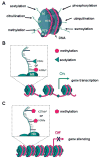Epigenetic mechanisms facilitating oligodendrocyte development, maturation, and aging
- PMID: 19373939
- PMCID: PMC2760733
- DOI: 10.1002/glia.20881
Epigenetic mechanisms facilitating oligodendrocyte development, maturation, and aging
Abstract
The process of oligodendrocyte differentiation is regulated by a dynamic interaction between a genetic and an epigenetic program. Recent studies, addressing nucleosomal histone modifications have considerably increased our knowledge regarding epigenetic regulation of gene expression during oligodendrocyte development and aging. These results have generated new hypotheses regarding the mechanisms underlying the decreased efficiency of endogenous remyelination in response to demyelinating injuries with increasing age. In this review, we present an overview of the epigenetic mechanisms regulating gene expression at specific stages of oligodendrocyte differentiation and maturation as well as the changes that occur with aging.
(c) 2009 Wiley-Liss, Inc.
Figures


Similar articles
-
Post-translational modifications of nucleosomal histones in oligodendrocyte lineage cells in development and disease.J Mol Neurosci. 2008 May;35(1):13-22. doi: 10.1007/s12031-007-9014-x. J Mol Neurosci. 2008. PMID: 17999198 Free PMC article. Review.
-
Histone modifications affect timing of oligodendrocyte progenitor differentiation in the developing rat brain.J Cell Biol. 2005 May 23;169(4):577-89. doi: 10.1083/jcb.200412101. Epub 2005 May 16. J Cell Biol. 2005. PMID: 15897262 Free PMC article.
-
Age-dependent epigenetic control of differentiation inhibitors is critical for remyelination efficiency.Nat Neurosci. 2008 Sep;11(9):1024-34. doi: 10.1038/nn.2172. Nat Neurosci. 2008. PMID: 19160500 Free PMC article.
-
Epigenetic regulation of oligodendrocyte identity.Trends Neurosci. 2010 Apr;33(4):193-201. doi: 10.1016/j.tins.2010.01.007. Epub 2010 Mar 12. Trends Neurosci. 2010. PMID: 20227775 Free PMC article. Review.
-
Oligodendrocyte process outgrowth in vitro is modulated by epigenetic regulation of cytoskeletal severing proteins.Glia. 2003 Dec;44(3):264-74. doi: 10.1002/glia.10290. Glia. 2003. PMID: 14603467
Cited by
-
Epigenetic mechanisms in neurological disease.Nat Med. 2012 Aug;18(8):1194-204. doi: 10.1038/nm.2828. Nat Med. 2012. PMID: 22869198 Free PMC article. Review.
-
Epigenetic determinants of healthy and diseased brain aging and cognition.JAMA Neurol. 2013 Jun;70(6):711-8. doi: 10.1001/jamaneurol.2013.1459. JAMA Neurol. 2013. PMID: 23571692 Free PMC article. Review.
-
Oligodendrocyte progenitors as environmental biosensors.Semin Cell Dev Biol. 2021 Aug;116:38-44. doi: 10.1016/j.semcdb.2020.09.012. Epub 2020 Oct 19. Semin Cell Dev Biol. 2021. PMID: 33092959 Free PMC article. Review.
-
HOTAIR but not ANRIL long non-coding RNA contributes to the pathogenesis of multiple sclerosis.Immunology. 2018 Apr;153(4):479-487. doi: 10.1111/imm.12850. Epub 2017 Nov 16. Immunology. 2018. PMID: 29030863 Free PMC article.
-
A Comprehensive Examination of the Role of Epigenetic Factors in Multiple Sclerosis.Int J Mol Sci. 2024 Aug 16;25(16):8921. doi: 10.3390/ijms25168921. Int J Mol Sci. 2024. PMID: 39201606 Free PMC article. Review.
References
-
- Asklund T, Appelskog IB, Ammerpohl O, Ekstrom TJ, Almqvist PM. Histone deacetylase inhibitor 4-phenylbutyrate modulates glial fibrillary acidic protein and connexin 43 expression, and enhances gap-junction communication, in human glioblastoma cells. Eur J Cancer. 2004;40:1073–1081. - PubMed
-
- Battiste J, Helms AW, Kim EJ, Savage TK, Lagace DC, Mandyam CD, Eisch AJ, Miyoshi G, Johnson JE. Ascl1 defines sequentially generated lineage-restricted neuronal and oligodendrocyte precursor cells in the spinal cord. Development. 2007;134:285–293. - PubMed
-
- Benevolenskaya EV. Histone H3K4 demethylases are essential in development and differentiation. Biochem Cell Biol. 2007;85:435–443. - PubMed
-
- Boyer LA, Plath K, Zeitlinger J, Brambrink T, Medeiros LA, Lee TI, Levine SS, Wernig M, Tajonar A, Ray MK, Bell GW, Otte AP, Vidal M, Gifford DK, Young RA, Jaenisch R. Polycomb complexes repress developmental regulators in murine embryonic stem cells. Nature. 2006;441:349–353. - PubMed
Publication types
MeSH terms
Substances
Grants and funding
LinkOut - more resources
Full Text Sources
Medical

